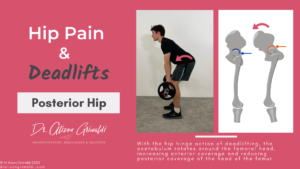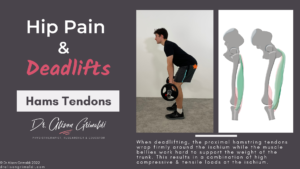DEADLIFTS – MODIFYING FOR HIP PAIN
| 6 January 2022
1
MODIFYING DEADLIFTS FOR HIP PAIN
- Avoid end range overload, control the lever arm and increase load sharing with the knee
- Reduce range of hip flexion and trunk inclination – Lift from a rack rather than the floor
- Reduce lumbar lordosis/anterior pelvic tilt – Don’t overarch lower back
- Choose bent-knee rather than stiff-legged styles – No RDL’s
- Keep the weight as close to the thighs/shins as possible
- Stop the hip extension thrust
- Reduce weight and volume of training
EXACERBATION OF ANTERIOR HIP PAIN IN DEADLIFTS
- Anterior hip pain may be provoked at peak hip flexion and/or peak hip extension.
- With a traditional deadlift that involves lifting a barbell from the floor, the hips are in high ranges of hip flexion, which may give rise to impingement related issues.
- However, in a deadlift the pelvis is free to move. This means that those with limited hip range, for example due to FAI, may compensate by moving into more posterior pelvic tilt and lumbar flexion. If overload does occur then, pain may be experienced at the anterior hip or in the lumbopelvic region, depending on how load is transferred.
- The other potential mechanism for aggravation of anterior hip pain is at the other end of the movement cycle, when returning to an upright position.
- Many gym trainers teach a hip extension thrust when returning to standing, which places large loads on the anterior hip joint and soft tissues.
- This is amplified by the concurrent cue to squeeze the gluteus maximus maximally during this terminal extension.
- The usefulness of this thrust from a training perspective is questionable, with the glute max mechanically disadvantaged at this point in range. There may be more risk than benefit in this cue, particularly for those with or at risk of anterior hip pain or injury.
EXACERBATION OF POSTERIOR HIP PAIN IN DEADLIFTS
- Compared to squat technique, the hip hinge action of the deadlift distributes higher loads to the hip and lower loads to the knee. This is very beneficial for targeted hip extensor strengthening. However, in certain situations this load may be intolerable.
1. Exacerbation of hip pain associated with posterior instability
- Those with reduced posterior hip stability will often struggle with the deadlift action and may be at risk of significant injury if inappropriate loads are applied in this position. Posterior instability is more likely in those with:
- acetabular dysplasia
- acetabular retroversion
- previous trauma (posterior subluxation or dislocation)
- hypermobility spectrum disorders/EDS
- iatrogenic reduction in capsular integrity (posterior approach arthroplasty)
- femoroacetabular impingement.
- The high challenge is inherently linked with trunk position, effect of gravity and long levers when lifting loads in this position. While reduced posterior stability is not so concerning in an upright position because the superior joint is absorbing the load, when the trunk inclines forward and the pelvis tips anteriorly, the load transmits to the posterior joint.
- More anterior tilt of the pelvis = less bony coverage of the femoral head = greater reliance on posterior capsuloligamentous structures.
- Adding a barbell to the hands at the end of the long lever of the trunk dramatically increases the challenge to the posterior joint. Pain provocation from this high challenge to the posterior joint, may be related to joint overload or, once again, to deep rotator overload +/- irritation of the adjacent sciatic nerve in those with deep gluteal syndrome. Sciatic nerve irritation in this situation is usually worse in the stiff-legged deadlift style, with higher levels of neural tension.
2. Exacerbation of hip pain associated with proximal hamstring tendinopathy
- The action of the deadlift creates a hinge around the hip joint and a pulley around the ischial tuberosity, where the proximal hamstring tendons wrap firmly around the ischium. The combination of high levels of tendon compression and tensile loads from the highly active hamstring muscles,1 can be provocative for those with proximal hamstring tendinopathy and tears. Stiff legged styles will be more provocative due to higher hamstring loads. The decision around if, and when to reintroduce deadlifts for proximal hamstring tendinopathy is not simply about symptoms. Structural integrity of the hamstring tendons should be considered.


